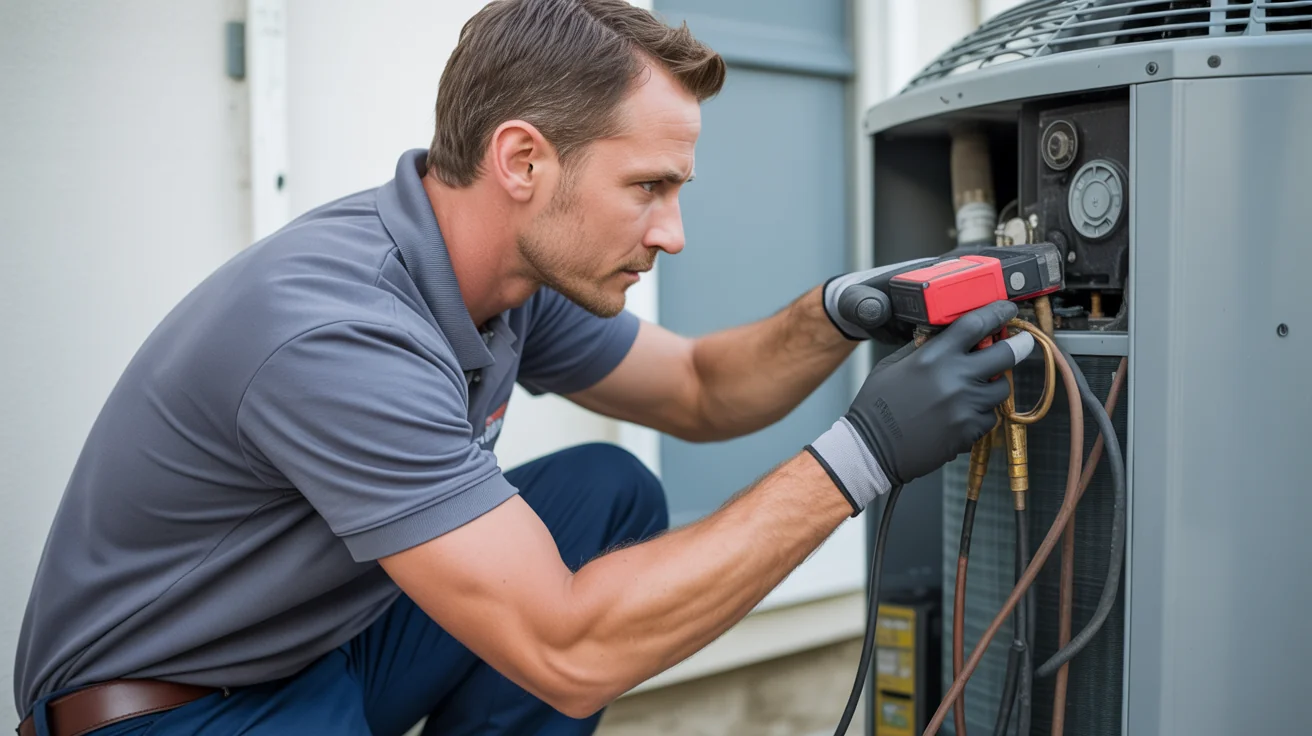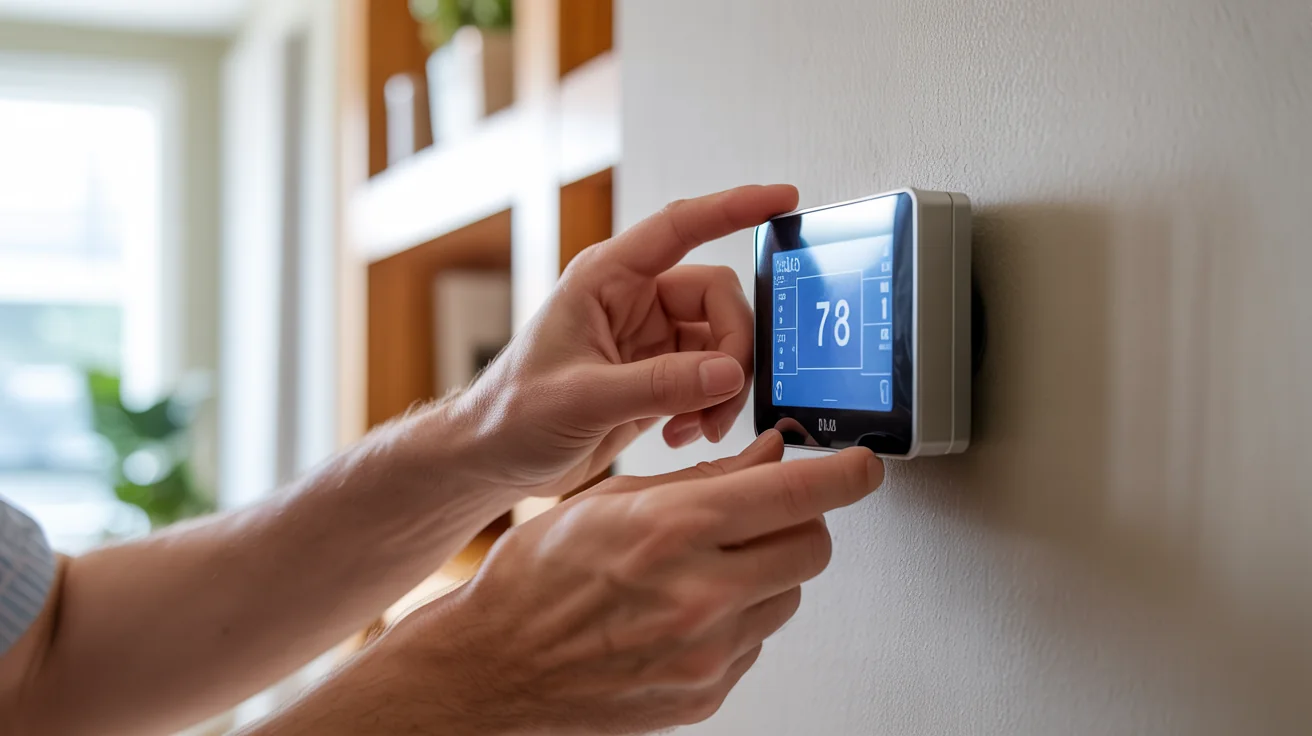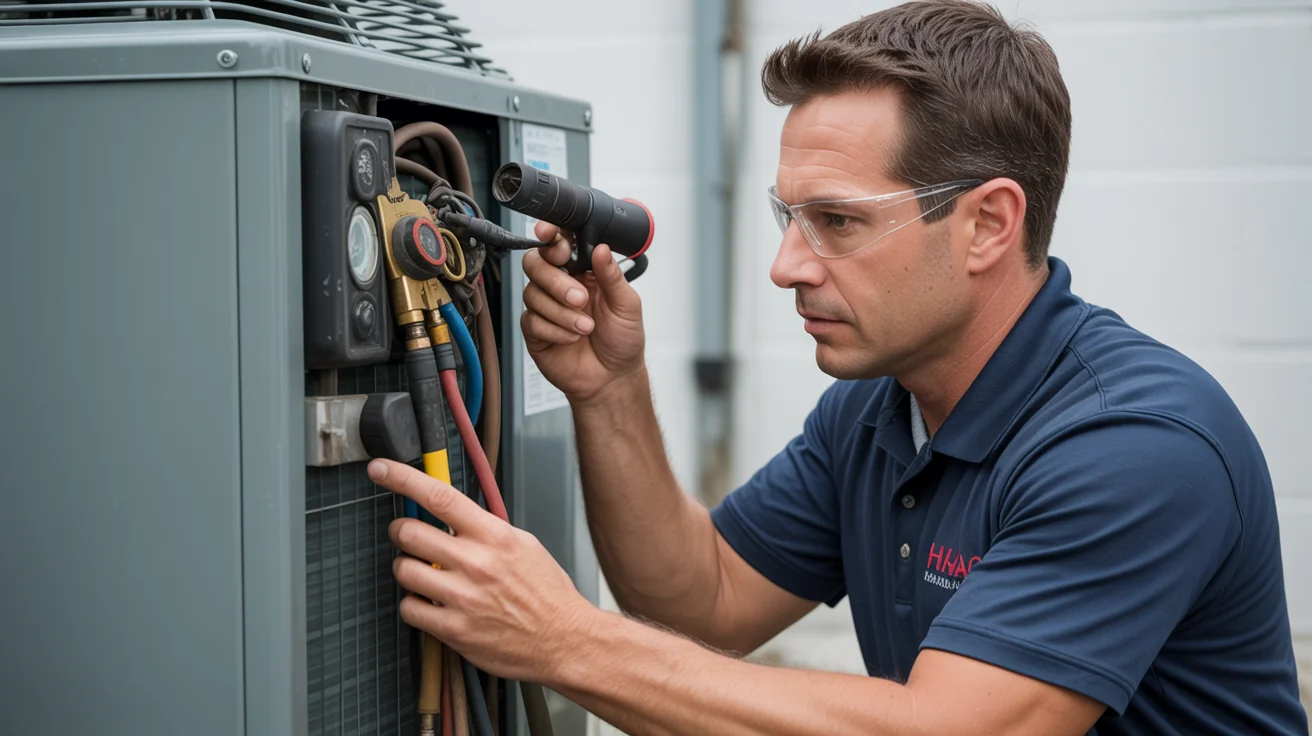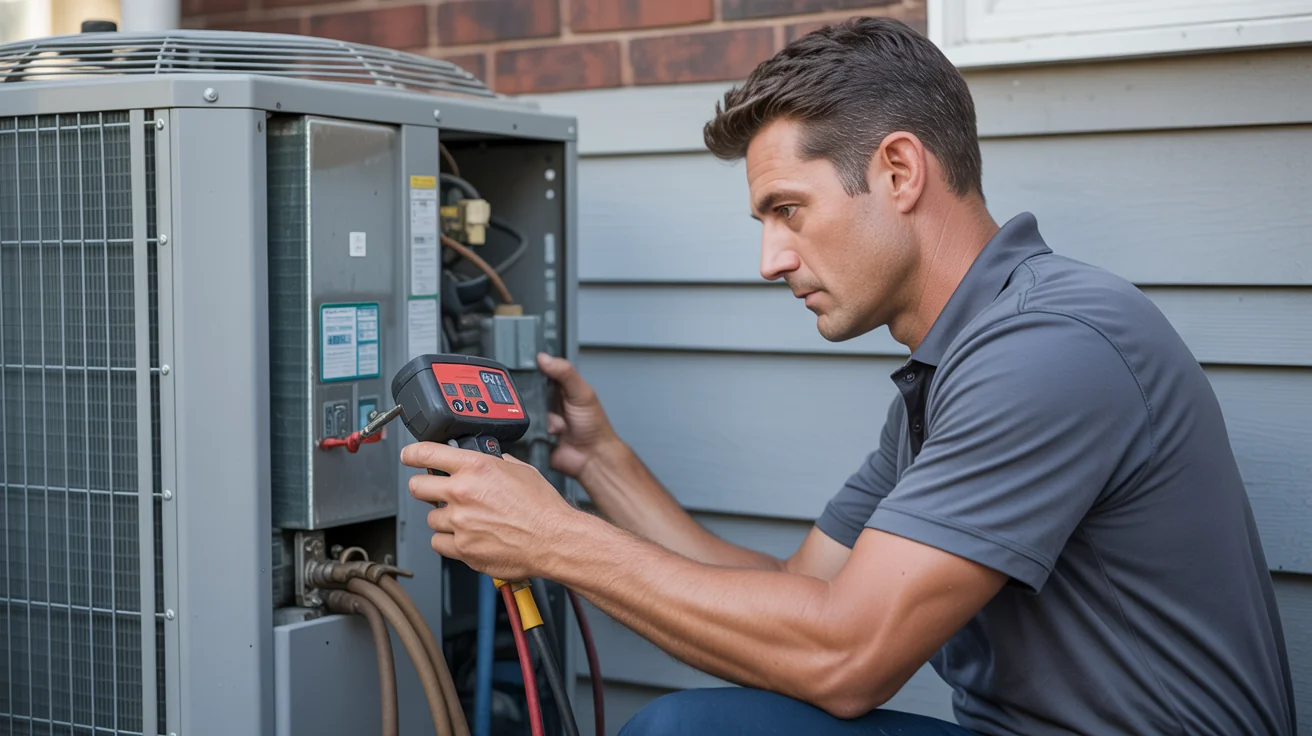End of Season AC Shutdown Procedures Texas 2025: Complete System Protection Guide
Complete Texas end-of-season AC shutdown guide covering proper procedures, winter protection, maintenance scheduling, and system preparation for optimal longevity.

Why Proper AC Shutdown Could Save You $5,000 Next Spring
Last March, I got a panicked call from a homeowner in Frisco. “My AC won’t start and it’s already 85 degrees!” When I got there, I found exactly what I expected - and dreaded.
They’d done what 90% of Texas homeowners do: simply stopped using their AC in November and hoped for the best. Six months later, they were facing a disaster that unfolded like a horror movie.
Moisture had collected inside the compressor over winter, causing internal corrosion that destroyed $2,200 worth of components. Mice had made themselves at home in the unit, chewing through low-voltage wiring - another $850. The outdoor unit looked like a nature preserve, packed with leaves, debris, and yes, an actual bird’s nest that had cost them another $650 to clean out properly. Worst of all, the refrigerant lines had developed pinhole leaks from months of thermal cycling without protection.
Total damage? Just shy of $5,000. All preventable with a simple $180 fall shutdown service.
Look, I get it. When that first cool day hits and you finally turn off the AC, the last thing on your mind is winter maintenance. Your system worked all summer - why wouldn’t it work next spring? But here’s what most people don’t understand: Texas weather doesn’t give your equipment a gentle break. It beats it up all summer, then subjects it to months of neglect.
After 15 years fixing these preventable disasters, I can tell you that hope is not a maintenance strategy. Your AC system is a sophisticated machine that just worked its tail off for six months straight. It deserves better than abandonment.
🚨 Need professional end-of-season AC shutdown service? Call Jupitair HVAC at (940) 390-5676 for complete system protection and spring startup preparation across North Texas.
Why Texas AC Systems Are Different (And Why That Matters)
Texas isn’t like other states. Your AC doesn’t get a nice, gradual wind-down period. One day it’s battling 105-degree heat, the next week it’s sitting idle while temperatures swing from 75 to 35 degrees. This creates problems you won’t find in Minnesota or Arizona:
What Makes Texas Brutal on AC Equipment:
Your system runs hard until November, then sits completely idle without the gradual seasonal transition that equipment in other climates enjoys. Crazy weather swings mean 75-degree Christmas days followed by 25-degree January nights, creating thermal stress that damages components through constant expansion and contraction. Gulf Coast humidity creates perfect conditions for corrosion and mold growth when systems sit idle for months in moisture-rich environments. Mild winters turn your outdoor unit into a five-star hotel for mice, rats, and birds who see the protected space as ideal shelter during cooler months.
What Your System Actually Needs:
Protection from moisture that turns into expensive corrosion requires proper drainage and weatherproofing that prevents water infiltration during idle periods. Electrical components need protection and inspection to ensure they won’t fail when you need them most after months of sitting unused. A barrier against critters who see your unit as prime real estate prevents costly damage from animals that nest in and chew on expensive system components. Your system deserves a fighting chance to start up smoothly when March temperatures suddenly hit 85°F and everyone in Texas tries to turn on their AC simultaneously.
When to Actually Shut Down Your System (Timing is Everything)
I get this question every fall: “When should I turn off my AC?” The answer isn’t on a calendar - it’s on your weather app.
Here’s What I Tell My Customers:
Wait for seven straight days below 70°F (not just nighttime lows - daytime highs) before considering shutdown because one warm day can justify keeping the system ready for operation. Check the 14-day forecast to ensure no surprise 85-degree days are lurking because Texas weather loves to surprise everyone with random warm spells. Watch humidity drop below 50% consistently because high humidity can make moderate temperatures feel much warmer and require continued AC operation. In North Texas, this usually happens between mid-November and early December, though climate patterns are becoming less predictable each year.
Regional Reality Check:
North Texas (DFW area) typically sees shutdown timing around mid-November if you’re lucky, sometimes not until December due to persistent warm weather patterns and urban heat island effects. East Texas experiences shutdown from late November to mid-December because that humidity lingers longer near the Louisiana border, keeping apparent temperatures elevated. Central Texas gets shutdown timing from December to early January since y’all get a longer cooling season thanks to your southern latitude and continental climate effects. South Texas residents should just give up on shutdown timing - good luck finding more than a week in January when you won’t need cooling at some point during the day.
Don’t Trust Your Phone’s Weather App (Seriously)
I’ve learned not to trust those basic weather apps for shutdown decisions. Here’s what I actually do:
I check NOAA’s 14-day extended forecast, not the pretty app on my phone, because accurate weather data is crucial for timing decisions that affect expensive equipment. I compare this year to the last five years to determine if this is an unusually warm or cool fall, helping predict whether the cooling season will extend longer than normal. I remember that downtown Dallas runs 8-10 degrees hotter than Frisco due to the urban heat island effect, so location significantly affects shutdown timing. I ask my customers: “Are you the type who cranks the AC when it hits 72, or do you tough it out until 80?” because personal comfort preferences greatly influence when systems can actually be shut down.
Smart Shutdown Strategy (Not All-or-Nothing):
Start raising your thermostat gradually - from 75 to 76 to 78 as outdoor temps drop - allowing your system to work less while staying ready for unexpected warm spells. Keep your system ready for those inevitable “wait, is it really 80 degrees in December?” days because Texas weather will absolutely surprise you when you least expect it. Protect your equipment even if you’re still using it occasionally by implementing protective measures and maintenance while maintaining operational readiness. When in doubt, call me - I’ve been watching North Texas weather patterns for 15 years and can help you make the right timing decision for your specific situation and location.
Comprehensive End-of-Season AC Shutdown Procedures
Thermostat and Control System Shutdown
Proper Thermostat Management:
- Set to “OFF” position completely disabling cooling system operation
- Fan setting to “AUTO” preventing continuous fan operation
- Temperature setting maintaining moderate setting for potential winter use
- Battery replacement ensuring thermostat maintains programming during shutdown
Smart Thermostat Considerations: Winter mode activation switching to heating-only operation if available. Schedule adjustment removing cooling schedules while maintaining heating. Remote monitoring maintaining connectivity for system oversight. Professional programming optimizing settings for seasonal transition.
Electrical System Protection
Circuit Breaker Management: Leave main breakers ON maintaining power to heating components and controls. Condenser unit protection considering disconnect switch position based on local conditions. Electrical component inspection checking for damage or deterioration. Professional electrical assessment ensuring safe winter storage.
Component-Specific Protection: Condensate pump power maintaining operation if heating system requires drainage. Control system power preserving thermostat and scheduling functions. Emergency restart capability ensuring ability to activate system if needed. Safety system operation maintaining smoke detectors and carbon monoxide sensors.
Outdoor Unit Winter Protection
Physical Equipment Preparation: Coil cleaning removing debris, leaves, and buildup from condenser coils. Unit inspection checking for damage, loose components, or wear signs. Refrigerant line protection ensuring proper insulation and support. Electrical connection verification securing all connections for winter weather.
Environmental Protection Measures: Debris removal clearing area around unit of leaves, branches, and obstacles. Drainage verification ensuring proper water runoff away from equipment. Cover considerations evaluating need for winter covers in specific climates. Landscaping preparation trimming vegetation that could damage equipment.
Indoor System Maintenance
Air Handler and Ductwork: Filter replacement installing fresh filter for heating season or storage. Blower component cleaning removing dust and debris from air handler. Ductwork inspection checking for damage, leaks, or pest intrusion. Drain pan cleaning preventing mold and bacteria growth during dormancy.
System Component Care: Evaporator coil inspection checking for damage or excessive buildup. Condensate system ensuring proper drainage and preventing backup. Indoor air quality addressing any filtration or purification system needs. Professional assessment complete evaluation of indoor components.
Professional vs. DIY Shutdown Procedures
Professional End-of-Season Service Benefits
Comprehensive Professional Shutdown: System performance evaluation spoting issues before next cooling season. Component inspection detecting wear or damage requiring attention. Preventive maintenance addressing minor issues before they become major problems. Documentation recording system condition and maintenance performed.
Professional Service Advantages: Expert assessment spoting problems homeowners might miss. Proper procedures ensuring shutdown follows manufacturer recommendations. Tools and equipment using professional-grade cleaning and testing equipment. Warranty protection maintaining manufacturer warranty compliance.
Safe DIY Shutdown Steps
Homeowner-Friendly Procedures:
- Turn off power at thermostat and potentially at electrical disconnect
- Clean outdoor unit removing debris and hosing down coils gently
- Replace indoor filter installing fresh filter for heating season
- Clear drain lines ensuring proper drainage flow
- Document condition taking photos of equipment for spring reference
DIY Safety Considerations: Electrical safety avoiding contact with electrical components. Chemical avoidance not using harsh cleaners on equipment. Professional limits recognizing when professional service is needed. Emergency contacts maintaining access to professional service if issues arise.
When Professional Service is Essential
Complex System Requirements: Heat pump systems requiring specialized seasonal transition procedures. Zoned systems needing professional balancing and control adjustment. High-efficiency equipment requiring manufacturer-specific maintenance procedures. Warranty compliance meeting professional maintenance needs.
Problem Identification: Unusual sounds or performance during end-of-season operation. Visible damage to equipment or components. Age considerations older systems requiring professional assessment. Efficiency concerns systems showing declining performance.
Winter AC System Monitoring and Care
Periodic Winter Inspection
Monthly Winter Checks: Visual equipment inspection checking for obvious damage or issues. Outdoor unit clearance ensuring continued debris-free operation area. Moisture accumulation watching for ice formation or drainage problems. Pest activity monitoring for signs of wildlife intrusion.
Weather Response Monitoring: Storm damage assessment checking equipment after severe weather. Ice formation monitoring for dangerous ice accumulation on equipment. Wind damage checking equipment remains properly secured. Flood protection ensuring equipment remains above water during winter storms.
Maintaining Heating System Integration
Dual-System Coordination: Heat pump operation if system provides both heating and cooling. Shared ductwork maintaining distribution system for heating operation. Filter replacement continuing regular filter changes during heating season. Professional coordination ensuring heating and cooling systems work together.
System Integration Benefits: Efficiency optimization ensuring both heating and cooling systems operate efficiently. Component protection maintaining shared components during off-season. Spring preparation keeping integrated systems ready for cooling season return. Cost management optimizing energy use across both systems.
Spring Startup Preparation During Winter
Pre-Season Planning
Winter Maintenance Planning: Service scheduling arranging spring startup service during winter months. Component assessment planning any needed repairs or replacements. Upgrade considerations evaluating efficiency improvements for next season. Budget planning preparing for spring service and potential repairs.
System Improvement Planning: Efficiency upgrades considering higher-efficiency equipment replacements. Control improvements evaluating smart thermostat or zoning upgrades. Air quality enhancements planning filtration or purification improvements. Preventive investments spoting maintenance that prevents future problems.
Early Warning System Monitoring
Winter System Monitoring: Unusual weather preparation maintaining ability to restart during warm spells. Component condition tracking monitoring for deterioration during off-season. Professional consultation periodic check-ins with hvac professionals. Problem identification early detection of issues requiring spring attention.
Spring Preparation Activities: Service appointment scheduling booking spring startup before peak demand. Parts availability ensuring needed components are available for spring service. System documentation maintaining records of winter observations and concerns. Efficiency preparation planning modifications for improved performance.
Regional Texas Considerations for AC Shutdown
North Texas (DFW Metroplex) Shutdown
Climate-Specific Factors: Variable winter weather requiring flexible shutdown and restart capability. Urban heat island effects potentially extending cooling season in city centers. Storm activity preparing for occasional severe weather during winter months. Humidity management addressing moisture concerns during mild, humid winters.
Regional Best Practices: December shutdown timing typically optimal for north texas climate. Heating system coordination ensuring smooth transition to winter heating. Professional service availability taking advantage of off-season service scheduling. Storm preparation maintaining equipment protection during winter storms.
East Texas Shutdown Considerations
High Humidity Concerns: Moisture management addressing year-round humidity affecting dormant equipment. Mold prevention ensuring proper drainage and ventilation during shutdown. Extended mild weather potentially requiring longer cooling season operation. Professional moisture control addressing humidity-specific maintenance needs.
Central and South Texas Adaptations
Extended Season Management: Later shutdown timing accounting for longer warm weather periods. Partial shutdown options maintaining some cooling capability during mild winters. Heat pump considerations coordinating with heating needs in transitional climates. Professional guidance determining optimal shutdown strategy for specific locations.
Cost-Benefit Analysis of Proper Shutdown
Professional Service Investment
End-of-Season Service Costs: Basic shutdown service: $120-200 for standard residential units. Comprehensive maintenance: $200-350 including cleaning and inspection. Problem identification: $250-400 if repairs or adjustments needed. System protection value: $500-2,000 in prevented spring startup problems.
Service Investment Benefits: Problem prevention avoiding costly spring startup repairs. System longevity extending equipment life through proper care. Efficiency maintenance preserving optimal performance for next season. Warranty protection maintaining manufacturer warranty compliance.
DIY Shutdown Savings and Limitations
DIY Cost Considerations: Time investment: 3-4 hours for thorough homeowner shutdown. Supply costs: $50-100 for filters, cleaning supplies, basic tools. Risk factors: potential for missing problems requiring professional attention. Skill limitations: complex systems requiring professional expertise.
When DIY Makes Sense: Simple systems with straightforward shutdown needs. Recent professional service with systems in known good condition. Homeowner experience with basic hvac maintenance procedures. Professional backup maintaining relationship with hvac service provider.
Common End-of-Season Mistakes to Avoid
Shutdown Timing Errors
Premature Shutdown: October shutdown missing potential warm weather periods. Weather-based mistakes shutting down before consistently cool weather. Comfort sacrifice creating uncomfortable conditions during warm spells. Energy waste restarting systems repeatedly due to poor timing.
Delayed Shutdown: December operation unnecessarily running systems during cold weather. Energy waste cooling during cold outdoor conditions. System stress operating equipment in inappropriate conditions. Utility cost increases from inefficient operation during cold weather.
Improper Protection Measures
Inadequate Cleaning: Dirty coils restricting airflow and efficiency when restarted. Debris accumulation causing damage during winter storage. Filter neglect allowing dust accumulation in system components. Drain problems creating moisture issues during dormant periods.
Electrical Mistakes: Complete power shutdown disabling heating system operation. Thermostat errors incorrect settings affecting heating operation. Safety system disruption inadvertently disabling important safety features. Control system problems losing programming or settings during shutdown.
Monitoring and Maintenance Neglect
Winter Neglect: Zero monitoring ignoring equipment condition during off-season. Storm damage ignorance failing to assess equipment after severe weather. Pest intrusion allowing wildlife to damage equipment unchecked. Professional consultation avoidance missing expert guidance during off-season.
Frequently Asked Questions
When should I shut down my AC system for the season in Texas?
Texas shutdown timing varies by region: North Texas: mid-november to early december when temperatures consistently stay below 70°f. Central Texas: late november to late december. South Texas: december to january, or potentially year-round operation. Weather-dependent: monitor extended forecasts for 7+ days below 70°f.
Professional consultation helps figure out optimal timing for your specific location and system.
Should I turn off power to my AC unit completely?
Power management depends on your system: Thermostat shutdown: always turn cooling mode to “off”. Circuit breakers: leave main power on if system shares heating components. Disconnect switches: consider local climate and professional recommendations. Heat pump systems: maintain power for heating operation.
Professional assessment figure outs safe electrical shutdown for your specific system.
Do I need professional service for end-of-season shutdown?
Professional service benefits include: Complex systems: heat pumps, zoned systems, or high-efficiency equipment. Problem identification: detecting issues before next cooling season. Warranty compliance: meeting manufacturer maintenance needs. System longevity: professional care extending equipment life.
Simple systems may handle DIY shutdown, but professional service provides complete protection.
How do I protect my outdoor AC unit during Texas winters?
Outdoor unit protection includes: Debris removal: clear leaves, branches, and obstacles from around unit. Coil cleaning: remove buildup for optimal spring startup. Inspection: check for damage requiring repair before next season. Drainage: ensure proper water runoff away from equipment.
Avoid covering units unless specific climate conditions require protection.
What maintenance should I perform during winter months?
Winter maintenance includes: Monthly inspections: visual checks for damage or problems. Storm response: assessing equipment after severe weather. Heating system care: maintaining shared components with heating system. Professional communication: staying in touch with hvac service provider.
How much does professional end-of-season service cost?
Professional service investment ranges: Basic shutdown: $120-200 for standard service. Comprehensive maintenance: $200-350 including inspection and cleaning. Problem resolution: $250-500 if issues require attention. Spring preparation: $300-600 for complete seasonal transition service.
Professional service typically prevents $1,000-5,000 in spring startup problems.
Professional End-of-Season AC Protection
Protect your AC investment and make sure smooth spring startup with professional end-of-season shutdown services from Jupitair HVAC. Our complete system protection prevents costly spring problems while extending equipment life and maintaining optimal performance.
Why Choose Jupitair for End-of-Season AC Service: 15+ years Texas experience understanding regional climate challenges and system needs. Comprehensive shutdown procedures protecting all system components during winter months. Spring startup preparation ensuring smooth transition back to cooling operation. Problem prevention focus spoting and addressing issues before they become expensive repairs.
Ready for professional AC system protection? Call (940) 390-5676 or contact us online for end-of-season shutdown service, winter maintenance, or spring startup preparation.
Don’t let improper shutdown create costly spring surprises. Professional end-of-season service protects your investment and make sures reliable cooling when Texas heat returns.
Need Professional HVAC Service?
Our certified technicians are ready to help with any HVAC needs in North Texas




